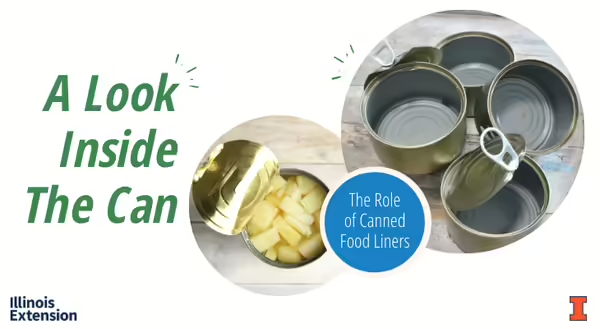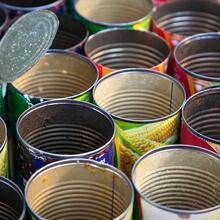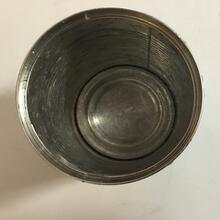
A community member called my office several years ago with a really interesting question: why does the liner of my can of pineapple look different from my canned beans? Until that question, I hadn't paid much attention to the inside of my cans, except to look at the food. I think about that question sometimes, so in honor of Canned Food Month in February, let's explore commercial canning and can liners (or coatings).
Roles of Canned Foods
A LOT of foods are canned, and for helpful reasons.
- Less Food Waste. If left fresh for a few days or a week, my pineapple would start to show signs of decomposing. Processing foods in cans and jars prevents otherwise edible foods from going in the trash or compost.
- Long Storage. The steps of canning help foods stay edible for a long time. USDA describes shelf life of canned foods this way: canned acidic foods, like tomatoes and fruits, keep peak quality for 12-18 months, and less acidic foods, like meats, vegetables, and beans, keep best quality for 2-5 years.
- Maintain Nutrition. There are six general categories of nutrients in food. Canning maintains the amounts of protein, carbohydrates, fats, and minerals in foods. Research shows that the amount of vitamins in canned food vary based on the vitamin and the food - sometimes the same as fresh, sometimes lower, and sometimes higher due to increased bioavailability.
- Better Taste than Out-of-Season. Ever eaten a fresh peach in the middle of winter? To me, they don't have great taste or texture. But canned peaches in the middle of winter are a tasty, good-quality option.
Before the Cannery
Illinois cans a lot of pumpkin puree, but this is after they've received the cans and lids needed to process the pumpkin. How are food cans made? What liners are used? What is the safety of the materials?
The Outer Can
The base of many drink bottles is aluminum. Food cans - like canned beans or fruits - tend to made of steel. While the term "tin can" might still be heard, tin is not a common metal in current food cans.
If you are curious about how food cans are shaped and assembled, scroll down to the Resources section. I listed different company and industry websites that explain the process. This is not a full list of companies or industries, nor is the list an endorsement of any company, products, or services.
Role of Can Liners
Liners - also called coatings - in food cans have to do some very specific things, including:
- Maintain quality of food, such as the foods' taste, texture, color, and smell
- Stay in good condition when the can is heated during food processing
- Stay attached to the outer can if/when the can gets dented
- Minimize interactions between the can and the food, such as corrosion of the metal
- Minimize migration - or movement - of the liner material into the food
Liner Materials
With all these roles for liners, there is no one coating that works with all foods. There are too many liner materials to describe in this blog post, so let's use the community member's question about canned pineapple as an example.
Acidic fruits - like pineapple - tend to be added to steel cans with a thin plating of tin, so it can appear like there is no liner in the can. The reason for this type of coating is because many fruits oxidize - or react with oxygen in the air - and turn dark in color. The tin reacts more easily with oxygen than the fruit, keeping oxygen away from the fruit and preventing the fruit from turning dark inside the can.
Scroll down to the Research and Resources sections to read more about the types of liners, materials they are made from, and which foods they might be used for. If you have a friend with a chemistry degree, I bet they'd enjoy chatting about this.
Liner Safety
The U.S. Food and Drug Administration sets standards for food container coatings in CFR Title 21, Part 175: Adhesives and Components of Coatings. Research of new and existing technologies by food scientists explore some of the roles of liners described earlier, such as how well a liner prevents corrosion or migration, like professor Gregory Ziegler's lab at Penn State.
Other research looks at the health impacts of animals and humans when exposed to liner compounds. Bisphenol A (BPA) may be one of the most well-known food container coatings. While being phased out of many products, research, including research done at the University of Illinois, observe that BPA alternatives may not be safer than BPA.
So researchers keep exploring. It's not time to give up canned foods, as they have important roles in food waste and food access. But if you are concerned and have access to alternatives, look at purchasing shelf-stable foods in glass containers and preserving foods at home.
Research:
- Adkison EC, Biasi WB, Bikoba V, Holstege DM, Mitcham EJ. Effect of Canning and Freezing on the Nutritional Content of Apricots. J Food Sci. 2018;83(6):1757-1761.
- Comerford KB. Frequent Canned Food Use is Positively Associated with Nutrient-Dense Food Group Consumption and Higher Nutrient Intakes in US Children and Adults. Nutrients. 2015;7(7):5586-5600. Published 2015 Jul 9.
- Durst RW, Weaver GW. Nutritional content of fresh and canned peaches. J Sci Food Agric. 2013;93(3):593-603.
- Rickman, J.C., Barrett, D.M. and Bruhn, C.M. (2007), Nutritional comparison of fresh, frozen and canned fruits and vegetables. Part 1. Vitamins C and B and phenolic compounds. J. Sci. Food Agric., 87: 930-944.
- Rickman, J.C., Bruhn, C.M. and Barrett, D.M. (2007), Nutritional comparison of fresh, frozen, and canned fruits and vegetables II. Vitamin A and carotenoids, vitamin E, minerals and fiber. J. Sci. Food Agric., 87: 1185-1196.
- LaKind, JS. Can coatings for foods and beverages: issues and options. Int. J. Technology, Policy and Management. 2013;13(1):80–95.
- The Aluminum Association, Aluminum Cans, N/D
- American Coatings Association, Changes to Corrosion Protection Coatings in Food Packaging, N/D
- Ball Metalpack, Food Cans, N/D
- Can Manufacturers Institute, Food Cans, N/D
- Canned Food Alliance, The Canning Process, N/D
- Container Supply Company, Metal Can Products, N/D
- Crown Holdings, Food Cans, N/D
- Geueke, B. (2016.) Can coatings. Food Packaging Forum
- Food Packaging Forum, Can Coatings, Webinar Recording, 2017
- Hook, P. and Heimich, J.E. (2017.) A History of Packaging. Ohio State University Extension, CDFS-133
- Koelsch Sand, C. (2020.) The Role of Metal in Food Packaging. Institute of Food Technologists. Food Technology Magazine. Vol. 74, No. 7
- Sherwin-Williams, Food Can Coatings, N/D
- Silgan Containers, Metal Food Containers, N/D
Related Resource:
For more about BPA, listen to the "Our Chemical Environment" webinars from the Interdisciplinary Health Sciences Institute at University of Illinois. Part 1 is titled A Primer on Toxicology and Endocrine-Disrupting Chemicals, and Part 2 is Phthalates, BPA, and the Developing Brain.
Healthy Eats and Repeat
How much difference is there between canned and frozen foods? How should you cook venison? When is the best time to buy avocados? Get answers to these questions as well as other tips, tutorials and recipes for common kitchen foods and items with University of Illinois Extension Nutrition & Wellness Educator Caitlin Mellendorf’s blog Healthy Eats and Repeat. Build your best life. Trust Extension to help.
Caitlin Mellendorf is an Illinois Extension Nutrition and Wellness Educator serving DeWitt, Macon and Piatt Counties in Central Illinois. She is a Registered Dietitian and her work focuses on helping community members gain the knowledge, skills and tools to live healthier, more nutritious lifestyles. This includes providing programs and answering questions about heart health, diabetes, food safety, food preservation, grocery shopping and cooking. You can reach Caitlin by email at chuth2@illinois.edu or call 217.877.6042. Check out her nutrition blog Healthy Eats and Repeats for seasonal recipes and of an exploration of common kitchen foods.

